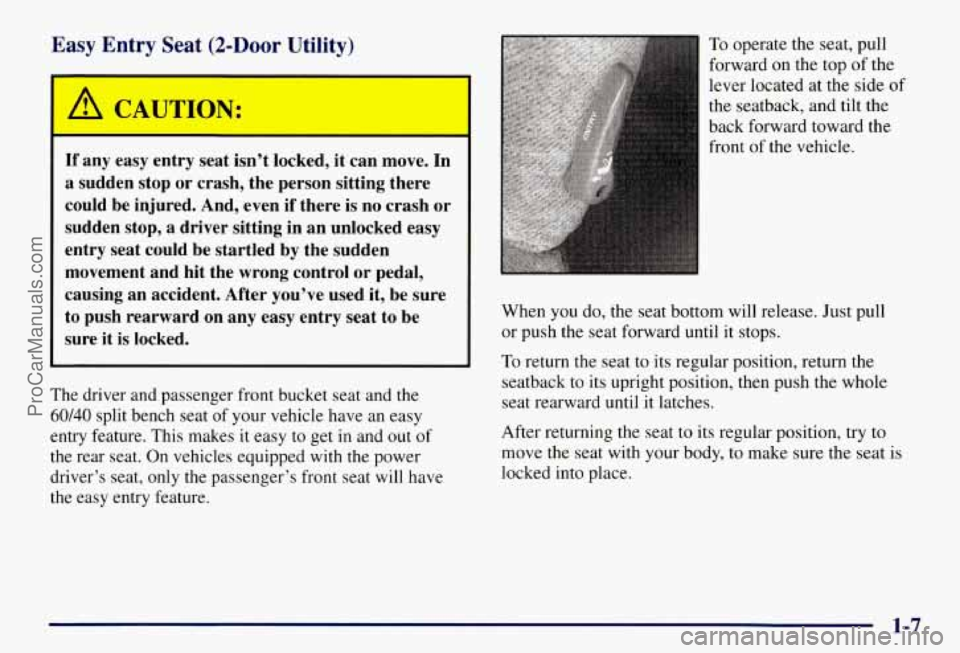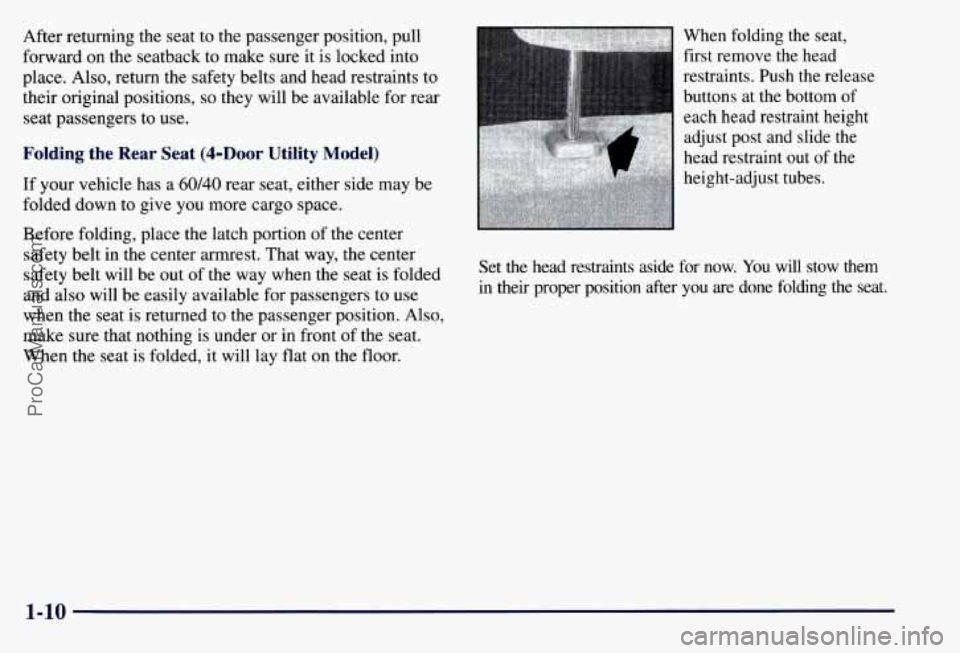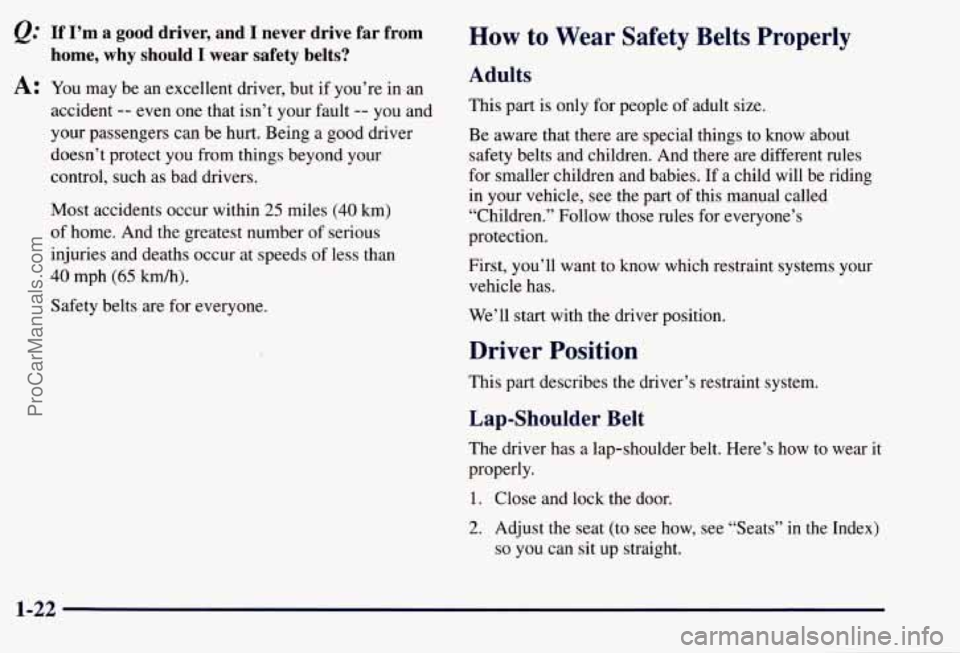Page 6 of 433
Vehicle Symbols
These are some of the symbols you may find on your vehicle.
For example,
these symbols
are used on an
original battery:
POSSIBLE A
CAUTION
INJURY
PROTECT EYES BY
SHIELDING
CAUSTIC
ACID COULD BAllERY
CAUSE
BURNS
AVOID
SPARKS
OR
FLAMES
SPARK
OR ,\I/,
COULD FLAME
EXPLODE BATTERY
These symbols
are important
for you and
your passengers
whenever your
vehicle is
driven:
DOOR LOCK
UNLOCK
FASTEN SEAT
BELTS
POWER
WINDOW
These symbols
have to
do with
your lamps:
SIGNALS e
TURN
WARNING
A
HAZARD
FLASHER
RUNNING
* . 0
DAYTIME
LAMPS
FOG LAMPS $0
These symbols
are on some
of
your controls:
WINDSHIELD
WIPER
WINDSHIELD DEFROSTER
WINDOW
DEFOGGER
VENTILATING FAN
These symbols are used on
warning and
indicator lights:
COOLANT -
TEMP -
CHARGING I-1
BATTERY
SYSTEM
BRAKE
(a)
COOLANT a
ENGINE OIL w,
PRESSURE
ANTI-LOCK
(@)
BRAKES
Here are some
other symbols
you may see:
FUSE
t
LIGHTER n
HORN )cr
SPEAKER
b
FUEL p3
V
ProCarManuals.com
Page 13 of 433
Head Restraints
Slide the head restraint up or down so that the top of the
restraint is closest to the top of your ears. This position
reduces the chance of a neck injury in a crash.
Seatback Latches (2-Door Utility)
I
If the seatback isn’t locked, it could move
forward in
a sudden stop or crash. That
could cause injury
to the person sitting there.
Always press rearward on the seatback to be
sure it
is locked.
The front seatback folds forward to let you access the
rear of the vehicle.
To fold a seatback forward,
pull this lever forward and
tilt the seatback forward.
To return the seatback to the upright position, just push
the seatback rearward until it latches.
After returning the seatback to its upright position, pull
the seatback forward to make sure it is locked.
1-6
ProCarManuals.com
Page 14 of 433

Easy Entry Seat (2-Door Utility)
1
If any easy entry seat isn’t locked, it can move. In
a sudden stop or crash, the person sitting there
could be injured. And, even if there is no crash or
sudden stop, a driver sitting in an unlocked easy
entry seat could be startled by the sudden
movement and hit the wrong control or pedal,
causing an accident. After you’ve used it, be sure
to push rearward on any easy entry seat to be
sure it is locked.
The driver and passenger front bucket seat and the
60/40 split bench seat of your vehicle have an easy
entry feature. This makes it easy
to get in and out of
the rear seat. On vehicles equipped with the power
driver’s seat, only the passenger’s front seat will have
the easy entry feature. To
operate the seat, pull
forward
on the top of the
lever located at the side of
the seatback, and tilt the
back forward toward the front
of the vehicle.
When you do, the seat bottom will release. Just pull
or push the seat forward until it stops.
To return the seat to its regular position, return the
seatback
to its upright position, then push the whole
seat rearward until it latches.
After returning the seat to its regular position, try
to
move the seat with your body, to make sure the seat is
locked into place.
1-7
ProCarManuals.com
Page 17 of 433

After returning the seat to the passenger position, pull
forward on the seatback to make sure it is locked into
place. Also, return the safety belts and head restraints
to
their original positions, so they will be available for rear
seat passengers to use.
Folding the Rear Seat (&Door Utility Model)
If your vehicle has a 60/40 rear seat, either side may be
folded down
to give you more cargo space.
Before folding, place the latch portion of the center
safety belt in the center armrest. That way, the center
safety belt will be out of the way when the seat is folded
and also will be easily available for passengers to use
when the seat is returned to the passenger position. Also,
make sure that nothing is under or in front of the seat.
When the seat is folded, it will lay flat on the floor. When folding
the seat,
first remove the head
restraints. Push the release
buttons at the bottom of
each head restraint height
adjust post and slide the
head restraint out of the
height-adjust tubes.
Set the head restraints aside for now. You will stow them
in their proper position after you are done folding the seat.
1-10
ProCarManuals.com
Page 29 of 433

If I’m a good driver, and I never drive far from
home, why should
I wear safety belts?
A: You may be an excellent driver, but if you’re in an
accident
-- even one that isn’t your fault -- you and
your passengers can be hurt. Being a good driver
doesn’t protect you from things beyond your
control, such as bad drivers.
Most accidents occur within
25 miles (40 km)
of home. And the greatest number of serious
injuries and deaths occur at speeds of less than
40 mph (65 kmh).
Safety belts are for everyone.
How to Wear Safety Belts Properly
Adults
This part is only for people of adult size.
Be aware that there
are special things to know about
safety belts and children. And there are different rules
for smaller children and babies. If a child will be riding
in your vehicle, see the part of this manual called
“Children.” Follow those rules for everyone’s
protection.
First, you’ll want to know which restraint systems your
vehicle has.
We’ll start with
the driver position.
Driver Position
This part describes the driver’s restraint system.
Lap-Shoulder Belt
The driver has a lap-shoulder belt. Here’s how to wear it
properly.
1. Close and lock the door.
2. Adjust the seat (to see how, see “Seats” in the Index)
so you can sit up straight.
1-22
ProCarManuals.com
Page 48 of 433
4-DOOr Utility
1. Pick up the latch plate and pull the belt across you.
Don’t let it get twisted.
2. Push the latch plate into the buckle until it clicks.
Pull up
on the latch plate to make sure it is secure.
When the shoulder belt is pulled out all the way, it
will lock.
If it does, let it go back all the way and
start again.
2-Door Utility and Suburban
1-41
ProCarManuals.com
Page 49 of 433
4-DOOr Utility
3. To make the lap part tight, pull down on the buckle
end
of the belt as you pull up on the shoulder part. The lap
part of the belt should be worn low and snug on
the hips, just touching the thighs. In a crash, this applies
force to the strong pelvic bones. And you’d be less likely
to slide under the lap belt.
If you slid under it, the belt
would apply force at your abdomen. This could cause
serious or even fatal injuries. The shoulder belt should go
over the shoulder and across
the chest. These parts of the
body are best able to take belt restraining forces.
The safety belt locks if there’s a sudden stop or a crash.
1-42
ProCarManuals.com
Page 50 of 433
Four-door utility models and the second seat of
Suburbans have shoulder belt height adjusters. Move
the shoulder belt height adjuster to the height that is
right for you.
To move the height adjuster down, push in at the word
PRESS and move the height adjuster to the desired
position.
You can move the adjuster up just by pushing
up on the shoulder belt guide. After you move the
adjuster to where
you want it, try to move it down
without pushing in to make sure it has locked into
position.
Adjust the height
so that the shoulder portion of the
belt is centered on your shoulder. The belt should be
away from your face and neck, but not falling
off
your shoulder.
I
You can be seriously hurt if your shoulder belt is
too loose. In a crash, you would move forward
too much, which could increase injury. The
shoulder belt should fit against your body.
1-43
ProCarManuals.com